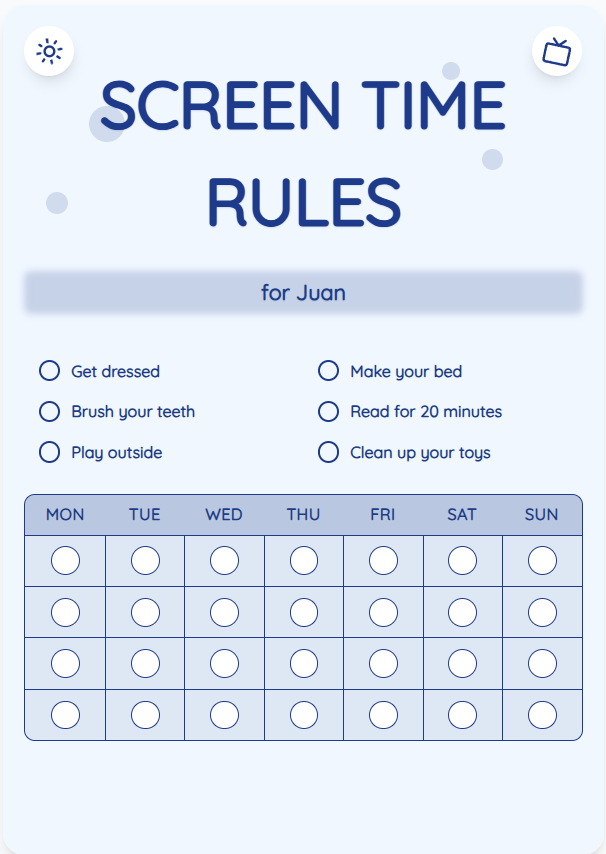Implementing the Screen Time 20-20 Rule: A Parent's Guide
As a parent, managing your child's screen time can be challenging. The Screen Time 20-20 rule offers a simple yet effective strategy to balance digital activities with other essential aspects of your child's development. In this guide, we'll explore how you can implement this rule successfully and create a healthy screen time routine for your children.
See What Your Screen Time Chart Will Look Like
Here's an example of a beautiful, customizable screen time rules chart you can create for your family

Understanding the Screen Time 20-20 Rule
The Screen Time 20-20 rule suggests that for every 20 minutes of screen time, children should take a 20-second break to rest their eyes and engage in physical activity. This rule aims to reduce eye strain, promote physical movement, and prevent excessive screen time consumption. By incorporating this rule into your child's daily routine, you can encourage healthier screen habits and overall well-being.
Practical Tips for Implementing the 20-20 Rule
1. Set timers or use screen time management apps to track your child's screen usage. 2. Encourage outdoor play or other non-screen activities during break times. 3. Create a screen time chart using ScreenTimeRules.com to visually organize your child's daily screen time schedule. 4. Lead by example and limit your own screen time to demonstrate healthy habits to your children.
Put These Tips Into Action
Create a custom chart to implement these strategies with your child
Establishing Screen-Free Zones and Times
Designate areas in your home where screens are not allowed, such as the dinner table or bedroom. Implement screen-free times during family meals and before bedtime to promote better sleep quality and family interaction. By creating boundaries around screen usage, you can cultivate a more balanced and mindful approach to technology within your household.
Monitoring and Adjusting Screen Time Limits
Regularly monitor your child's screen time habits and be prepared to adjust the limits based on their individual needs and behavior. Encourage open communication about screen time rules and collaborate with your child to establish a system that works for the whole family. Remember that flexibility and consistency are key elements in successfully implementing the Screen Time 20-20 rule.
Practical Tips for Success
- Set clear boundaries and expectations regarding screen time usage.
- Encourage alternative activities like reading, art, or outdoor play.
- Use positive reinforcement and rewards for following the 20-20 rule consistently.
Frequently Asked Questions
How can I handle resistance from my child when implementing the 20-20 rule?
Start by having an open conversation with your child about the importance of taking breaks and engaging in other activities besides screens. Involve them in creating their screen time schedule to give them a sense of ownership and responsibility.
Is it okay for my child to have some screen time without following the 20-20 rule?
While it's important to encourage breaks and physical activity, occasional deviations from the rule are acceptable. The goal is to promote balance and moderation in screen usage rather than strict adherence to a rigid schedule.
Can the Screen Time 20-20 rule be applied to all age groups?
The 20-20 rule can be adapted for different age groups, with younger children requiring more frequent breaks and shorter screen sessions. Adjust the rule based on your child's developmental stage and individual needs.
By implementing the Screen Time 20-20 rule with practical tips and strategies, you can create a healthy screen time routine that promotes your child's overall well-being. Visit ScreenTimeRules.com to generate personalized screen time charts and take the first step towards managing your child's digital habits effectively.
Ready to Transform Your Family's Screen Time?
Join thousands of parents who have successfully managed screen time with our customizable charts.
